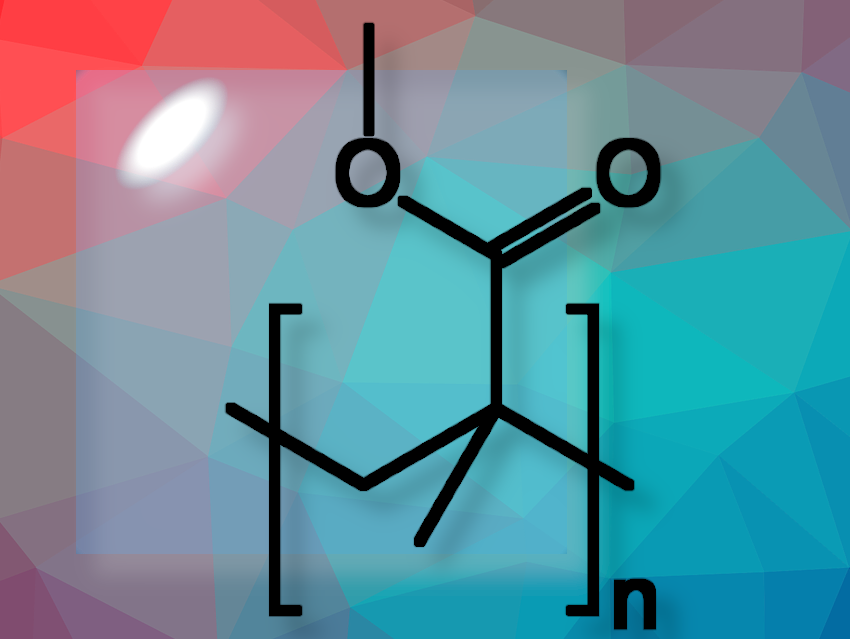PLEXIGLAS® is closely associated with the German chemist Otto Röhm and his company. Dr. Otto Röhm officially registered the brand PLEXIGLAS® in the trademark register on August 9, 1933.
What is PLEXIGLAS®?
Poly(methyl methacrylate) (PMMA), sometimes referred to as acrylic glass, is a synthetic polymer and transparent thermoplastic derived from methyl methacrylate. The starting material for PMMA is the monomer methyl methacrylate (MMA). The polymeric material shows good mechanical strength, exceptional optical properties such as clarity, brilliance, and transparency, and good weather resistance.
PMMA has diverse applications across various domains. It is commonly used as a sheet material, providing a lightweight and shatter-resistant alternative to glass. Additionally, it serves, e.g., as a casting resin, an ingredient in inks and coatings, and is used in signage, displays, LED screens, building windows, medical lenses, dental prosthetics, etc. thanks to its durability, compatibility with human tissue, and relevant biocompatibility in biotechnology.
The Start of the Brand
Otto Röhm (1876 – 1939) obtained his doctorate in 1901 on the subject of “On polymerization products of acrylic acid”. After completing his studies, he worked in 1902 at the pharmaceutical company Merck, as well as at the gasworks in Stuttgart, Germany, where he devoted himself to the processing of animal hides, which he treated with carbonated water.
Together with his friend and sales man Otto Haas, Otto Röhm founded the company Röhm & Haas OHG on September 6, 1907, in Esslingen, Germany. The company initially focused on developing enzymatic agents for leather tanning. Recognizing the efficacy of enzymes from animal pancreases in tanning hides, Otto Röhm revolutionized the techniques then used in the leather industry. His process was significantly differed from the existing practices. The company expanded rapidly and in 1909 relocated to Darmstadt, Germany, and established its first subsidiary in the USA, providing support to tanneries worldwide.
Today, there are two separate entities: Röhm GmbH in Darmstadt and Rohm and Haas Company in Philadelphia, PA, USA, which was acquired by Dow Chemical Company, USA, for $15 billion in 2009.
After founding a company for the manufacture of enzyme products with Otto Haas and generating sufficient profit for research purposes, Röhm returned to working on the topic of his doctoral thesis. He.assembled a team of researchers who, from the 1910s onward, worked on the synthesis and polymerization of acrylic and later methacrylic acid. The team first developed LUGLAS, a transparent, rubber-like material, used as a safety glass for windshields, with which the Röhm & Haas company established its plastics division.
PLEXIGLAS® was then launched on the market in 1933. In addition to Röhm, Dr. Walter Bauer, the head of the research laboratory, was involved in the development of PMMA in 1928. However, various other laboratories were likely also working on the polymer during that time. Röhm & Haas OHG was awarded the gold medal at the 1937 World Exhibition in Paris, France, for the invention.
With the Nazi regime’s interest in PLEXIGLAS®, its importance for everyday objects in civilian life soon receded into the background, and it was mainly used in the armaments industry for glazing the cockpits of fighter planes and bombers. After the Second World War, many civilian applications were developed for PLEXIGLAS®, starting with illuminated advertising, roof glazing, and façade design.
The company Röhm & Haas was renamed Röhm GmbH in 1971 after the Haas family left the company. In 1989, it became part of Hüls AG and, after several mergers, was absorbed into Evonik Industries AG. In 2019, the methacrylate activities—and thus also PLEXIGLAS®—were spun off and have since been run as an independent company, for which the traditional name Röhm GmbH was chosen.
And Today?
The company states that it continues to uphold Otto Röhm’s vision by maintaining a strong focus on research. Recently, it opened a new research center at its site in Worms, Germany. Otto Röhm is credited in more than 70 patents as either the sole inventor or co-inventor.
In the realm of sustainability, work is underway to introduce a waste management strategy. PLEXIGLAS® can be recycled multiple times. The company has already introduced sustainable PLEXIGLAS® “proTerra” sheets, a sustainably produced, high-quality acrylic, and molding materials with a reduced CO₂ footprint.
Sources
- Press release, PLEXIGLAS®: the original celebrates its 90th birthday!, Röhm GmbH, Darmstadt, Germany, August 9, 2023. (accessed August 9, 2023)
- Polymers for a clear, transparent view PLEXIGLAS®, Evonik Industries website (accessed August 9, 2023)
- Klaus Albrecht, Manfred Stickler, Thomas Rhein, Polymethacrylates, Ullmanns Encylopedia of Industrial Chemistry 2013. https://doi.org/10.1002/14356007.a21_473.pub2


